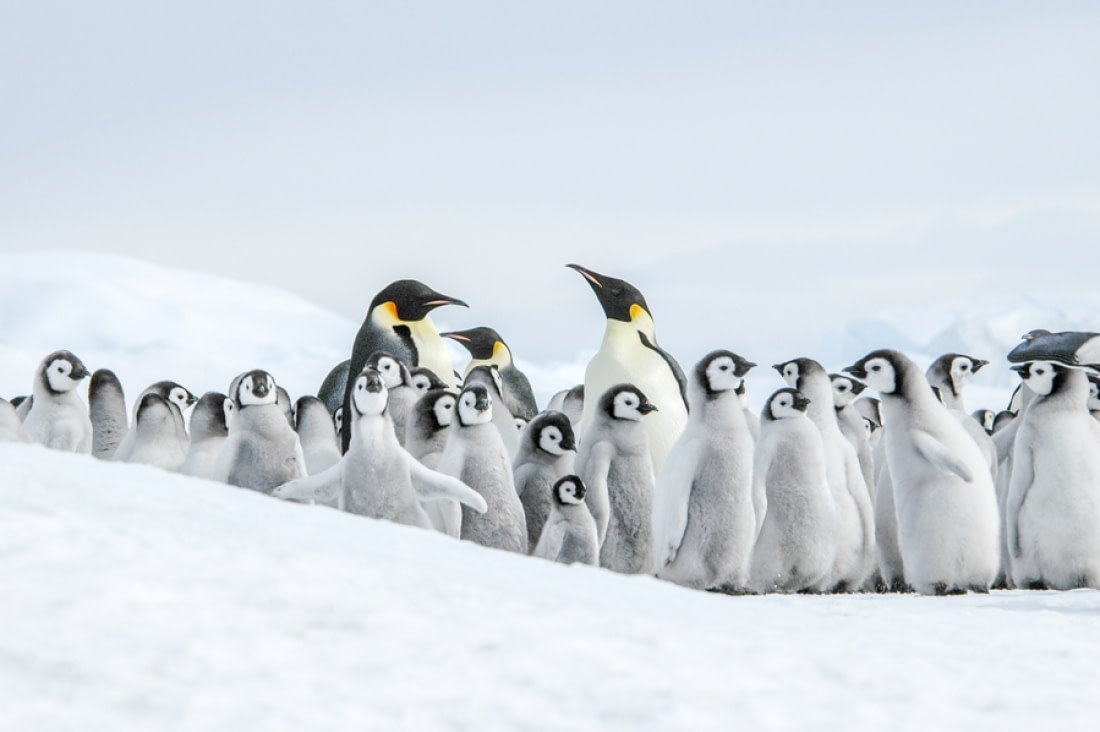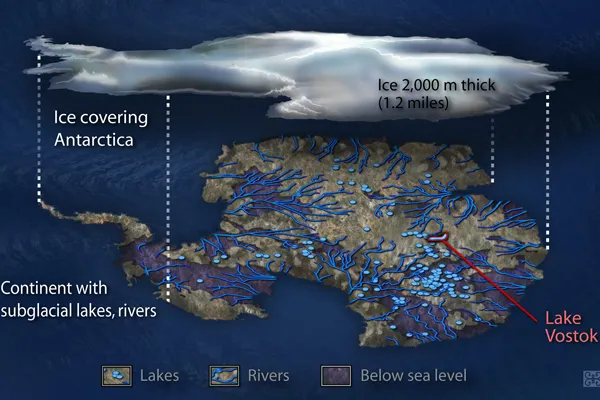1. penguins
Penguins and penguin colonies can be found in many places around Antarctica, but there are a few key locations they’re best found. One of the best among them is the emperor penguin colony at Snow Hill Island.
In addition, the Antarctic Peninsula is a great place to spot penguins, especially Adélies, gentoos, and chinstraps. In fact, Adélies only live in Antarctica, unlike other penguin species.More great penguin colonies exist farther north, in the sub-Antarctic islands of South Georgia (another amazing Antarctic attraction we’ll tell you more about later on).

2. 42 countries have research stations in Anctarctica (A report from Ocean Expeditions, a different agency says that there are only 29 countries represented but I put the Wikipedia map that is more beautiful).
Multiple governments have set up permanent research stations in Antarctica and these bases are widely distributed. Unlike the drifting ice stations set up in the Arctic, the research stations of the Antarctic are constructed either on rocks or on ice that are (for practical purposes) fixed in places.
Many of the stations are staffed throughout the year. A total of 42 countries (as of October 2006), all signatories to the Antarctic Treaty, operate seasonal (summer) and year-round research stations on the continent. The population of people performing and supporting scientific research on the continent and nearby islands varies from approximately 4,000 during the summer season to 1,000 during winter (June). In addition to these permanent stations, approximately 30 field camps are established each summer to support specific projects.
All white and the map is taken from Wikipedia
3. Antarctica is the largest ice sheet in the world
More than 98% of Antarctica is covered with ice. This makes it the largest ice sheet in the world, with Greenland coming in second. It is estimated that Antarctica contains around 90% of the world’s ice, and if it all melted, sea levels would rise by around 60 metres. https://www.secretatlas.com/explorers-club/antarctica/50-interesting-antarctica-facts-to-inspire-your-visit/
4. Antarctica used to be as warm as Melbourne
Given that the coldest ever land temperature was recorded in Antarctica of -89.2°C (-128.6°F), it can be hard to imagine Antarctica as a warm, temperate paradise. But Antarctica hasn’t always been an icy land locked in the grip of a massive ice sheet. In fact, Antarctica was once almost as warm as Melbourne is today.
Researchers have estimated that 40-50 million years ago, temperatures across Antarctica reached up to 17°C (62.6°F). Scientists have also found fossils showing that Antarctica was once covered with verdant green forests and inhabited by dinosaurs!
5. Endurance
Endurance was the three-masted barquentine in which Sir Ernest Shackleton and a crew of 27 men sailed for the Antarctic on the 1914–1917 Imperial Trans-Antarctic Expedition. The ship, originally named Polaris, was built at Framnæs shipyard and launched in 1912 from Sandefjord in Norway. After her commissioners could no longer pay the shipyard, the ship was bought by Shackleton in January 1914 for the expedition, which would be her first voyage. A year later, she became trapped in pack ice and finally sank in the Weddell Sea off Antarctica on 21 November 1915. All of the crew survived her sinking and were eventually rescued in 1916 after using the ship's boats to travel to Elephant Island and Shackleton, the ship's captain Frank Worsley, and four others made a voyage to seek help.
The wreck of Endurance was discovered on 5 March 2022, nearly 107 years after she sank, by the search team Endurance22. She lies 3,008 metres (9,869 ft; 1,645 fathoms) deep, and is in "a brilliant state of preservation".[1] The wreck is designated as a protected historic site and monument under the Antarctic Treaty System. https://en.wikipedia.org/wiki/Endurance_(1912_ship) 
6. The Initial Antarctic Dinosaur Discoveries
In 1990-91, scientists made the first discoveries of dinosaur fossils in the central Transantarctic Mountains of Antarctica. A site on Mt. Kirkpatrick, near the Beardmore Glacier, yielded the bones of Cryolophosaurus ellioti, a species wholly new to science. Alongside this specimen were the bones of a pterosaur (flying reptile), a tritylodont (mammal-like reptile), and another dinosaur later recognized as the new species Glacialisaurus hammeri.
All proved to be unique to Antarctica—evidence that by this point in time, barriers were preventing populations from exchanging genes across Pangaea. Additional excavations in 2003 on Mt. Kirkpatrick uncovered more bones of Cryolophosaurus at the original site, and bones of another Glacialisaurus (or perhaps a new dinosaur species) at a new site. Storms cut short the excavations of these quarries, leading to plans for the 2010-11 expedition.
All the white is taken from https://expeditions.fieldmuseum.org/antarctic-dinosaurs/antarctic-fossils

7. Diamond dust
Diamond dust is a meteorological phenomenon involving a cloud composed of tiny ice crystals. When it precipitates, it falls in the form of ice crystals which are so tiny that they appear to be suspended in the air. In sunlight, the crystals are visible and can sparkle in the light like diamonds.
For the formation of diamond dust, temperatures below 32 F are required or the ice will not be able to form. It has been described as being similar to fog in that the cloud of ice crystals forms at the surface. However, there are clear differences in that fog is a cloud of liquid water while diamond dust forms as ice. Also, fog reduces visibility but diamond dust does not have as much of an effect on visibility.
Crystals of diamond dust form as a well-defined hexagonal shape.
In Antarctica, diamond dust is common year-round and mostly occurs in the interior. It has been observed 316 days a year at Plateau Station in Antarctica. Although, diamond dust can precipitate for days, it will never accumulate like snow.
Diamond dust is mainly seen in polar and alpine regions. Thus, the phenomenon is mostly observed in Antarctica and the Arctic but can occur anywhere in the world where the winters are really cold.

8. The dispute to conquest the South Pole is a real tragicomedy that happened in the first years of the XXth Century. At the end, a Norwegian, Roal Amundsen, was the first to plant the Norwegian flag on December 14th, 1911 right in the South Pole, days before the Englishmen that were desperate to beat him got to arrive.
Captain Scott arrived to South Pole on January 17th, 1912 in an expedition that faced many issues and where he finished dead. It is such an interesting story to study that Austria's Stefan Zweig, one of the best writers of all times, wrote in 1927 a chapter of his Decisive Moments of History book dedicated not to Amundsen but to Scott.
Mecano, a Spanish musical group of the 80's and also one of the best Spanish musical group of all times, dedicated a song to Captain Scott based on the Zweig writings called Antarctica's Heroes. Even if it is in Spanish, enjoy the music, the tragicomedy finishes with this chef d'oeuvre.
9. Antarctica is the largest desert on earth, almost twice the size of the Sahara Desert.
When most people imagine Antarctica they think of a cold continent covered in ice. And they’re right. In fact, 90% of the world’s freshwater is locked up in Antarctica’s permanent ice sheet. By contrast, the idea of the desert usually conjures images of rippled sand dunes and the shimmering heat of the Sahara. So how is it possible that a cold, ice-covered continent like Antarctica is a desert?
Why is Antarctica a desert?
A desert is defined by the amount of precipitation (rain, snow, mist and fog) in an area. A region that receives very little precipitation (the exact amount depends on who you ask) is classified as a desert. There are many types of deserts, including subtropical, coastal and polar deserts. What they all have in common is a barren, windswept landscape, which makes it difficult for plants and animals alike to gain a foothold on land. This all certainly applies to Antarctica.
The average yearly rainfall at the South Pole over the past 30 years was a tiny 10 mm (0.4 in). Most of the continent is covered by ice fields carved by the wind, and craggy mountains covered in glaciers. While Antarctica is home to wonderful forests of low-lying mosses and lichens, there are only two flowering plants that can survive the harsh conditions. And most of the animals we encounter – penguins, seals, whales and seabirds – rely on seafood for sustenance.
Is there a desert in Antarctica, or is Antarctica a desert?
While most deserts only cover part of a continent, the Antarctic Polar Desert spans the whole of Antarctica. It snows and rains on the coastal Antarctic Peninsula, but in the McMurdo Dry Valleys in East Antarctica, it never rains. In fact, scientists believe that in some parts of the Dry Valleys it hasn’t snowed or rained for 14 million years! So although the coast sees some precipitation, the average across the continent is low enough to classify all of Antarctica as a polar desert.
How much of Antarctica is covered in ice?
Approximately 98% of the Antarctic continent is covered by a permanent ice sheet. This beautiful and wild expanse of ice covers an incredible 14 million km² (5.4 million square miles). That’s about the same area as the United States and Mexico combined!
At its deepest, Antarctica’s ice is 4.5km (2.7 miles) thick. If it melted, global sea levels would rise about 60 m (200 ft). That’s a lot of ice. And due to Antarctica’s desert conditions, it has taken an impressive 45 million years for it to grow to its current thickness.
How much precipitation does Antarctica receive annually?
The interior is very dry and rarely sees clouds. Here, the annual precipitation averages around 50 mm (1.9 in), and most of this falls as snow or ice crystals. This gives rise to some of the most ethereal weather conditions you can see on earth including frost flowers, solar haloes and polar stratospheric clouds.
By contrast, the coast has a maritime climate influenced by the ocean and it’s quite common to see low clouds and mist clinging to the craggy mountains. The Antarctic coastline can receive more than 200 mm (7.8 in) of precipitation each year.
On the Antarctic Peninsula, which travellers can visit in the summer months, it’s quite possible to see snow, rain and sunshine in one day. Some northern parts of the Antarctic Peninsula receive 500 mm (19.7 in) between October and March, and on nearby subantarctic islands this can double, with 1000 mm (39.4 in) each year! That’s why we make sure that everyone on our voyages has a top notch, complimentary polar expedition jacket. These jackets are water and wind-resistant, so you’ll be protected from the elements whatever the weather. https://www.aurora-expeditions.com/blog/is-antarctica-a-desert/
10. A lake is hidden under ice
hiding under the Antarctic ice is an entire lake: Lake Vostok is a pristine freshwater lake buried beneath 2.5 miles (3.7 kilometers) of solid ice. It is about the size of Lake Ontario, and is the largest of the more than 200 liquid lakes strewn around the continent under the ice.








